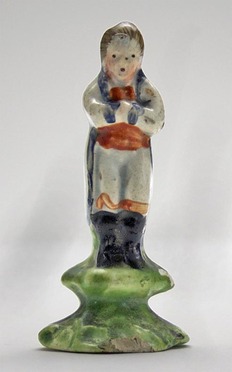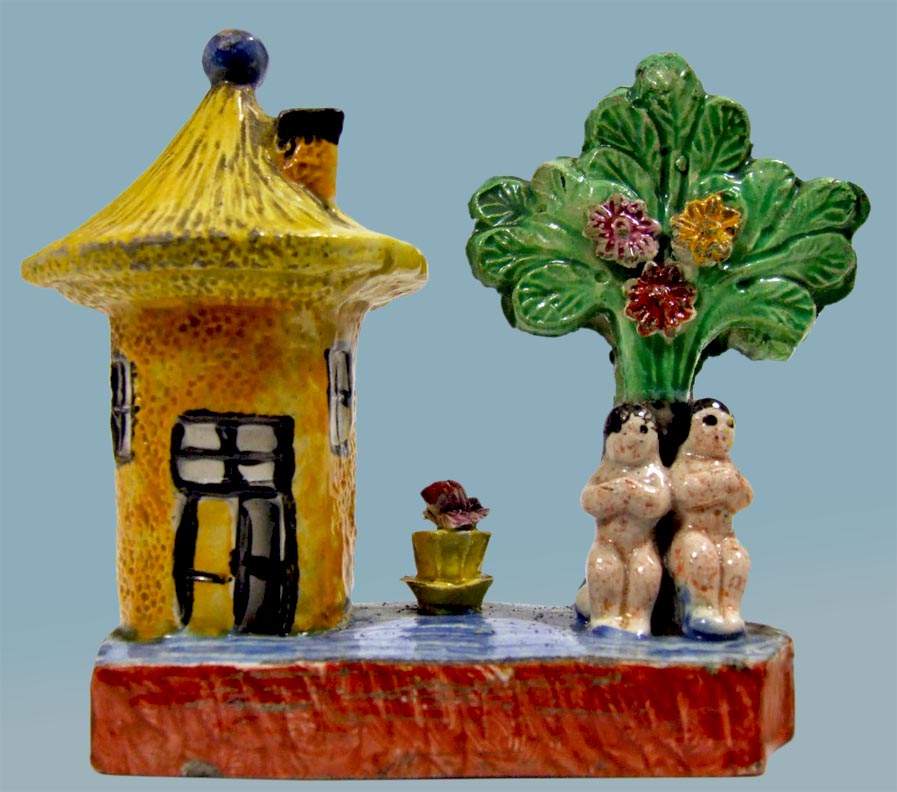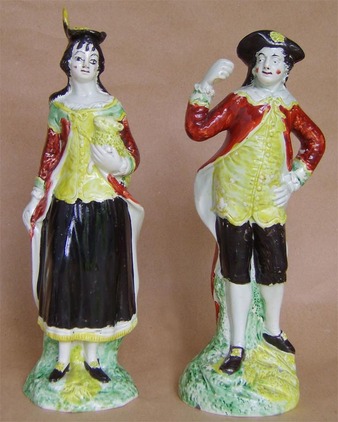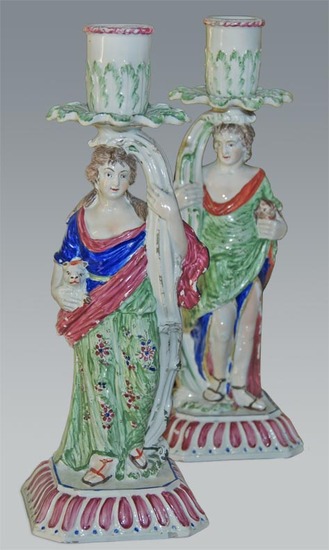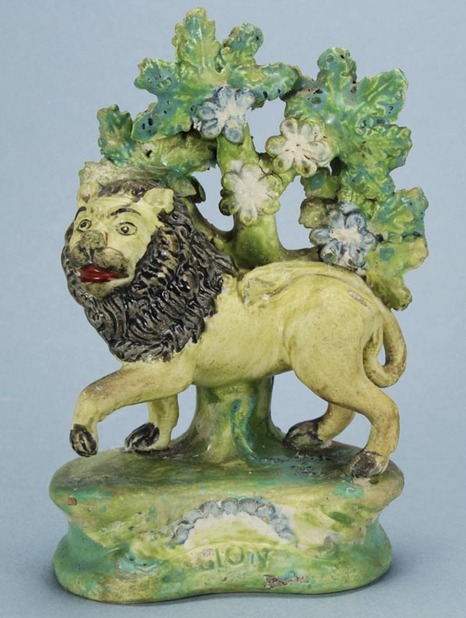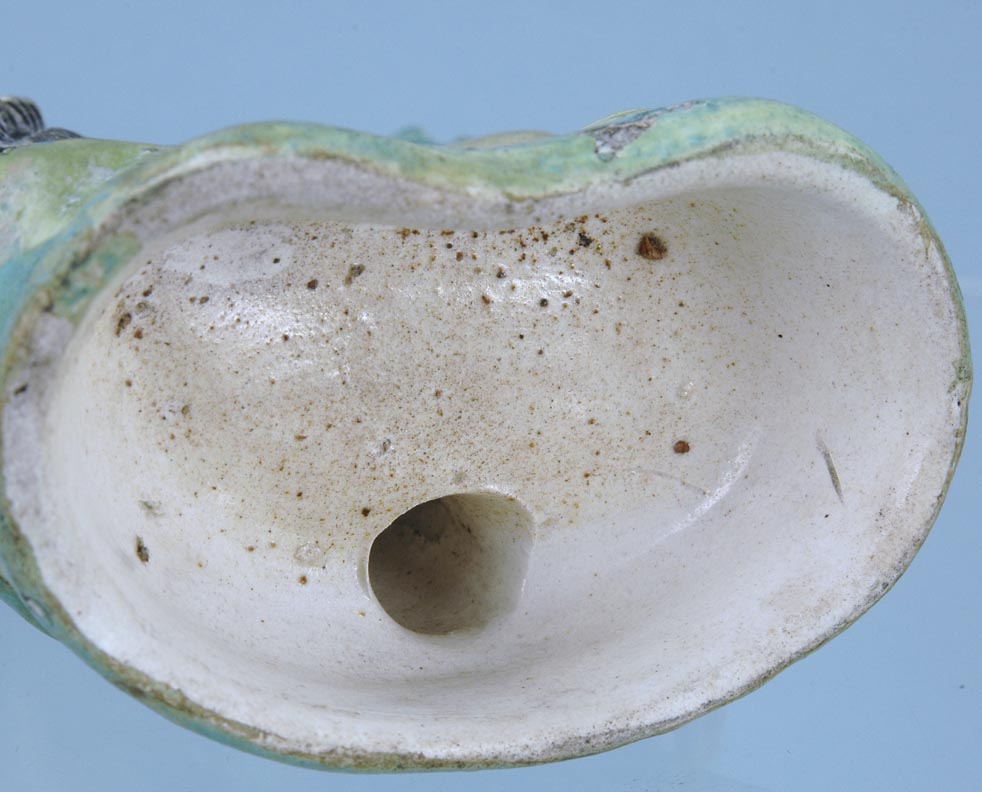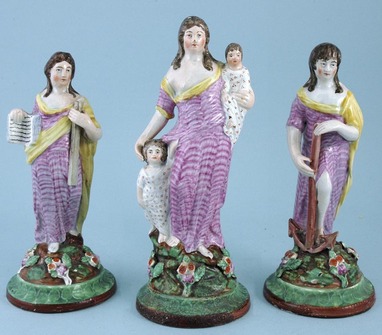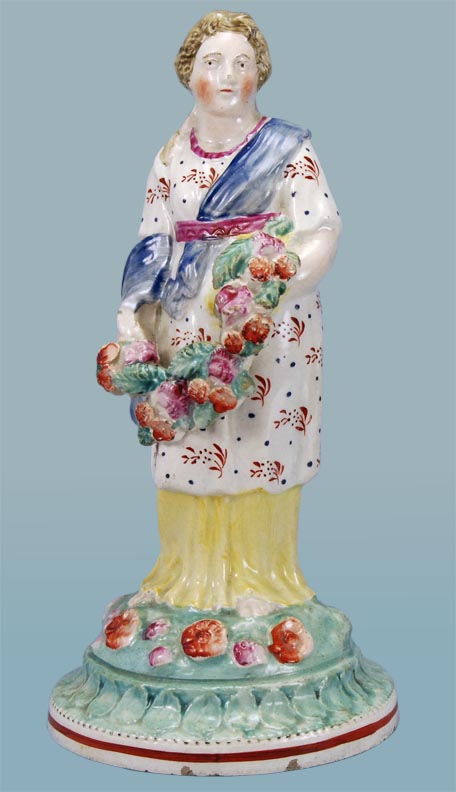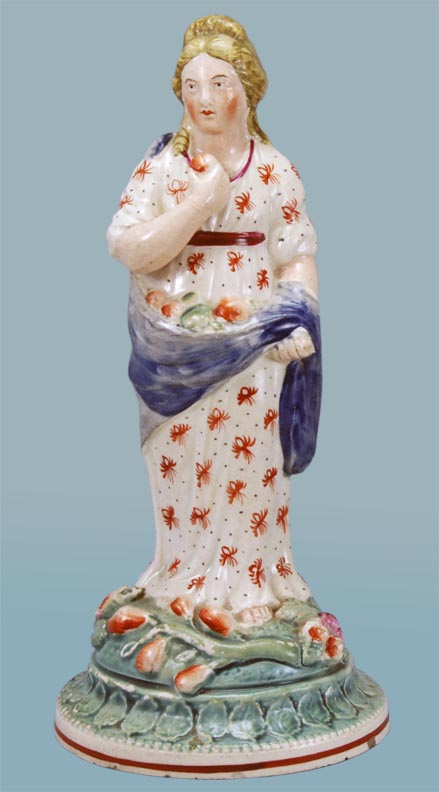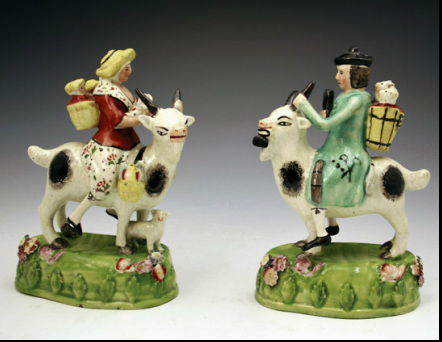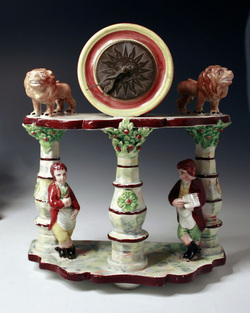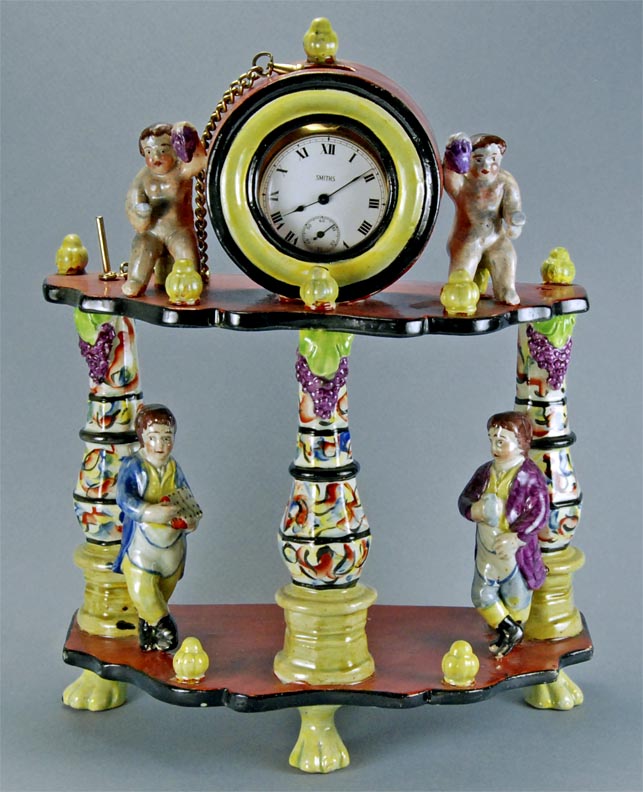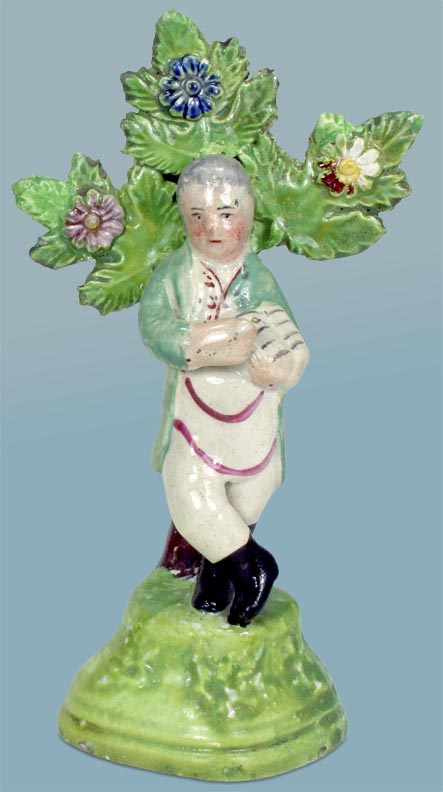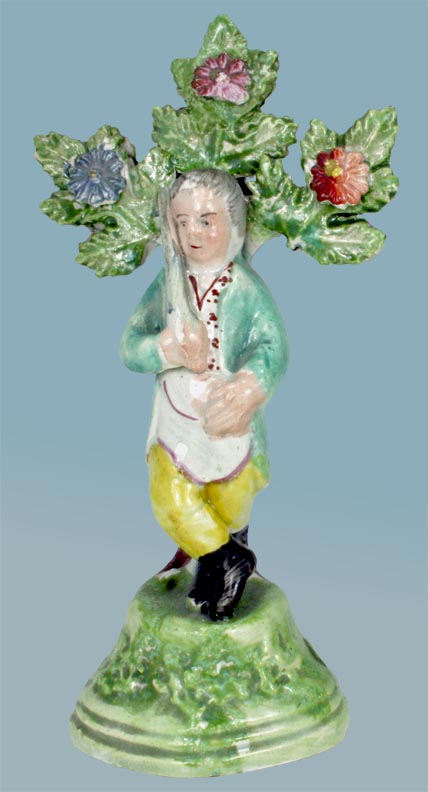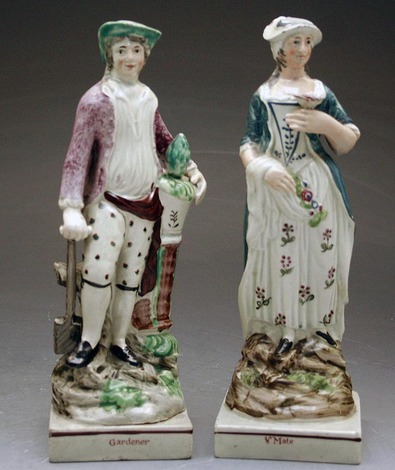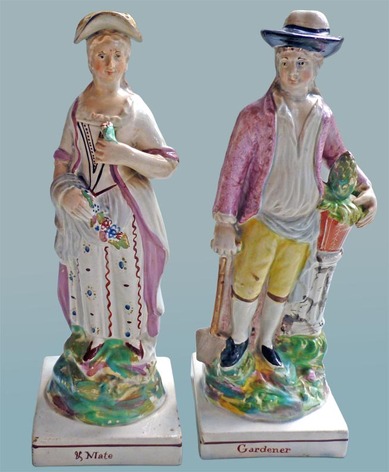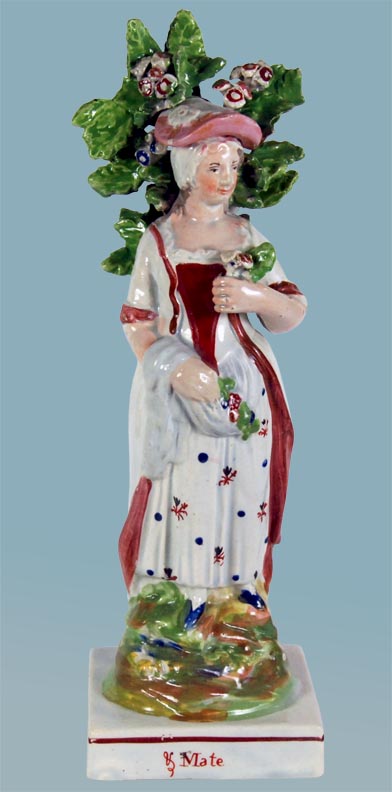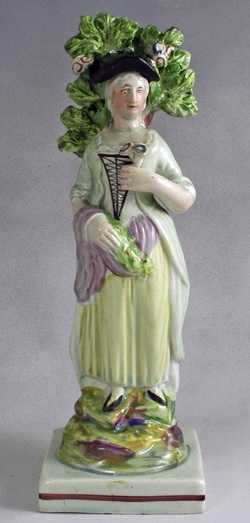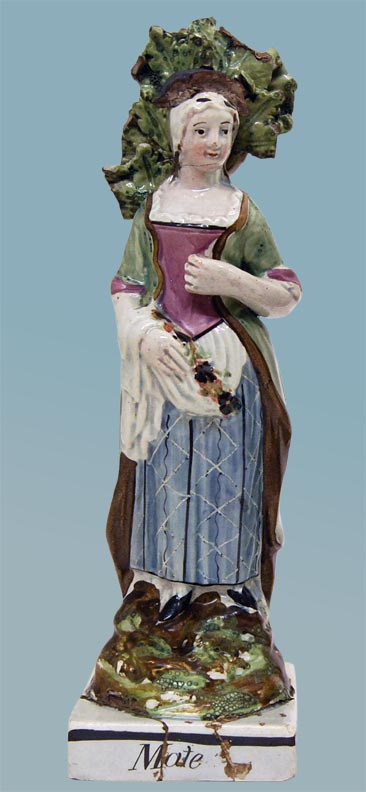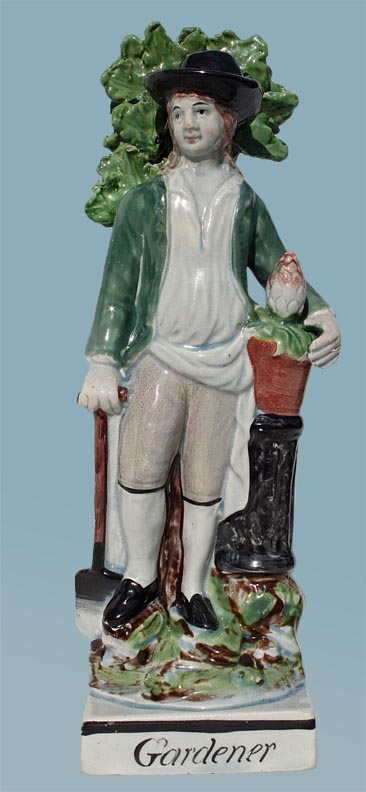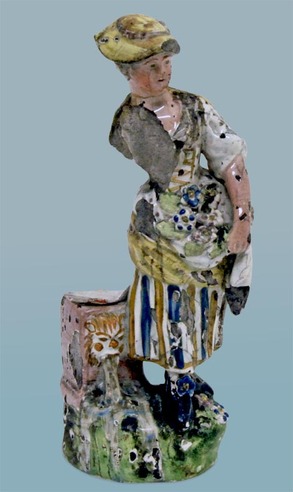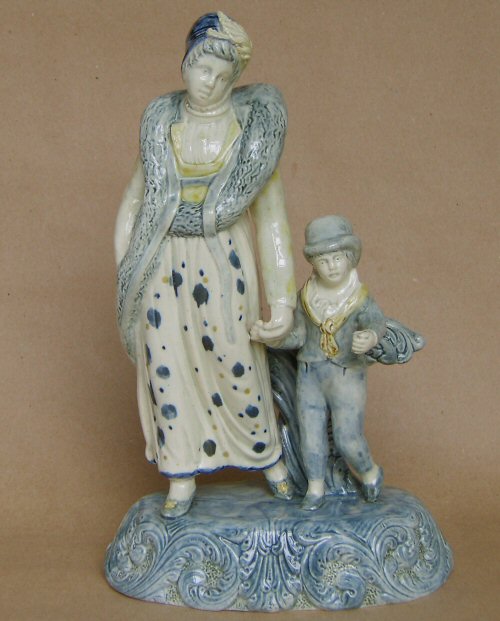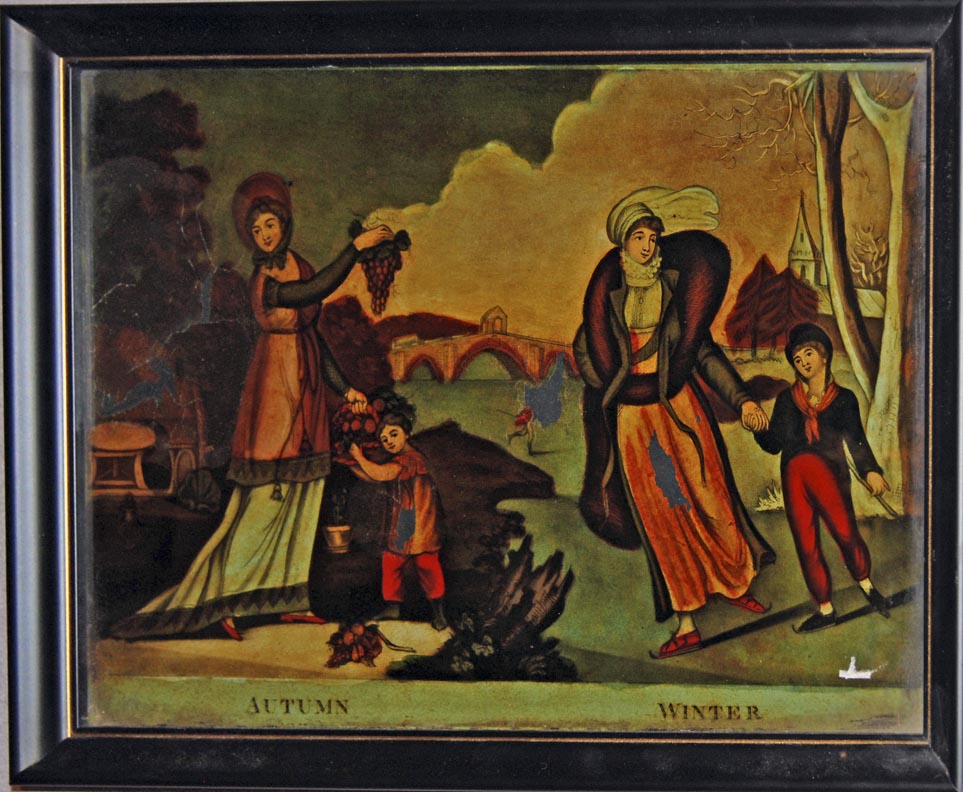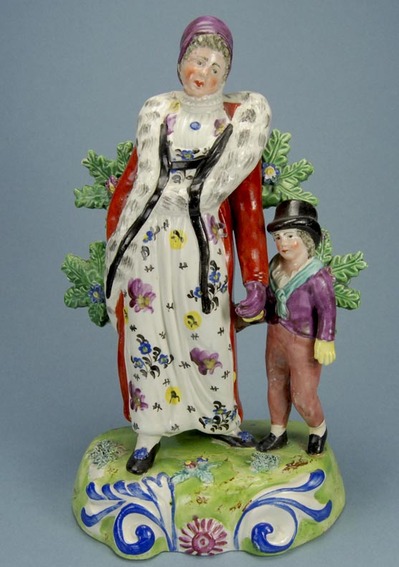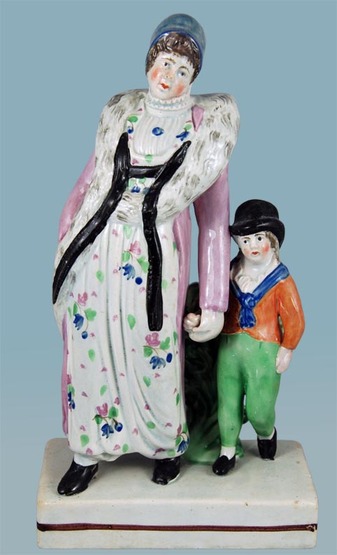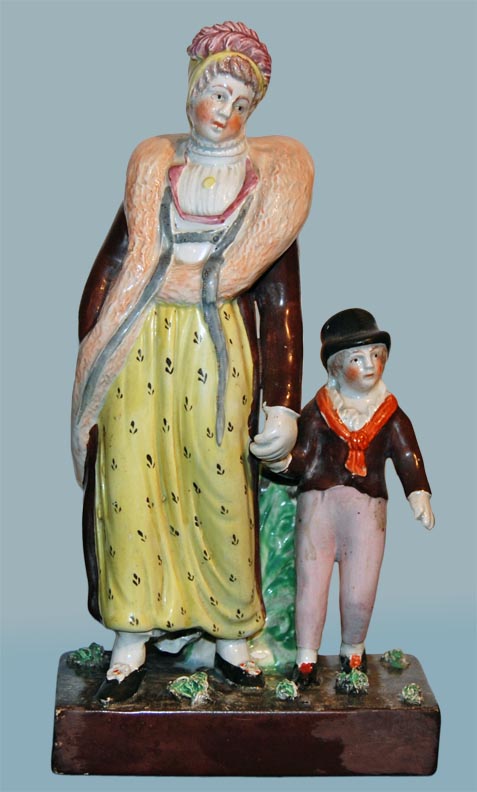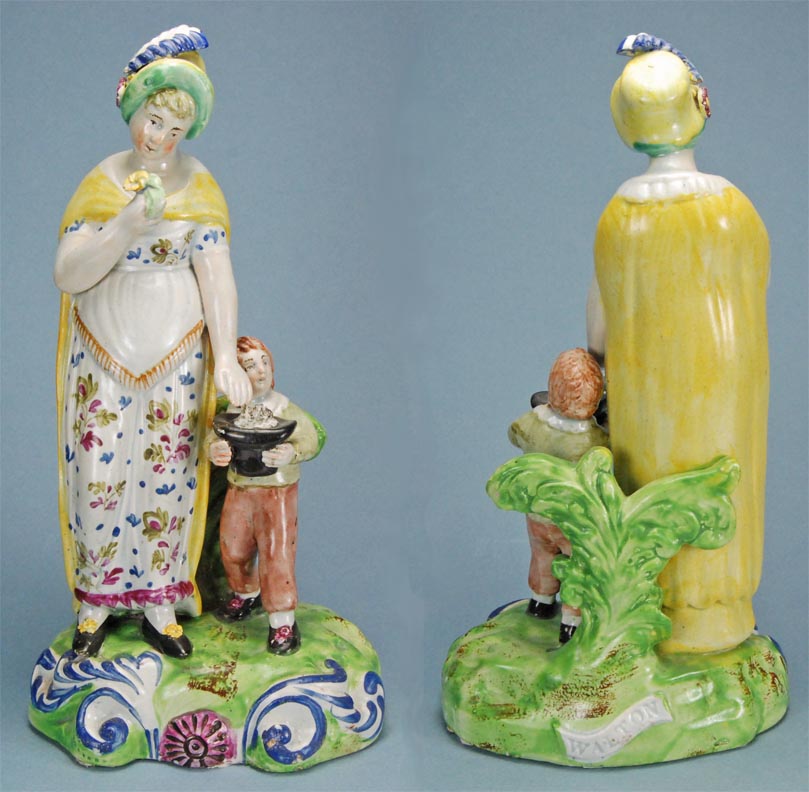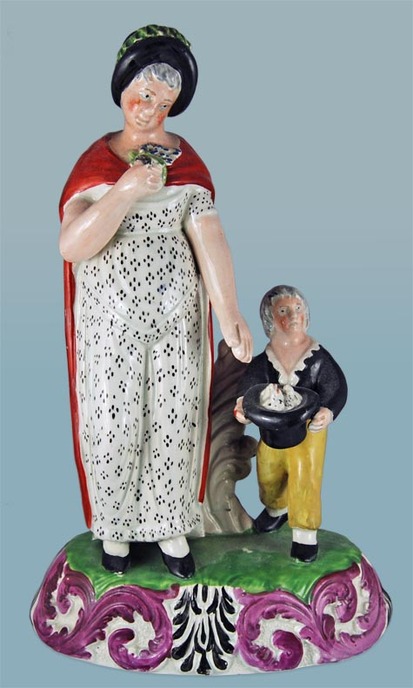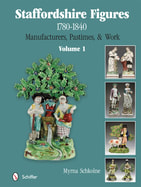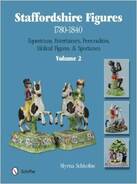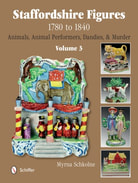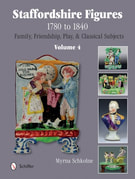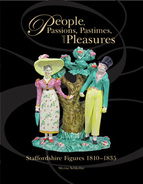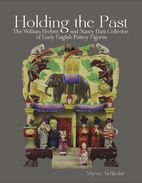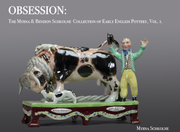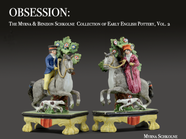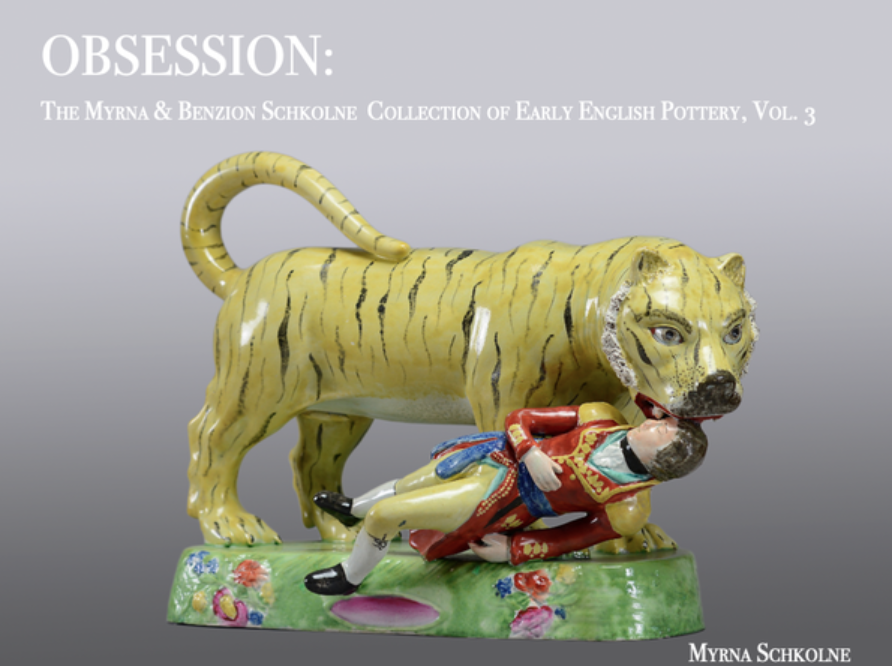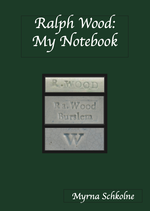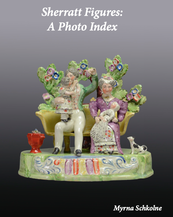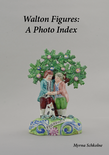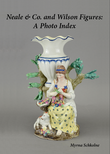|
In my May 8 blog, I showed an unrecorded and tiny Red Barn that has just sold to the trade for a lot of money. This must be the most expensive piece of property in Britain, where property is already by no means cheap! Despite that, it changed hands again quite quickly, and I now have additional pictures of it, which I am able to share. All I can say is WOW! Worth every penny, is it not? A true little gem. The tiny dumpy couple standing to the side are, of course, William Corder and Maria Marten, the victim-to-be. Interestingly, these little figures appear in no other context. And I know of no other example of this Red Barn. All quite puzzling, is it not? The figure is definitely attributable to "Sherratt." That base with two red lines occurs on a good number of other "Sherratt" figures, and the overall color palette etc. screams "Sherratt." This week, a collector sent me this photograph of yet another tiny treasure. This baby is under 3" tall, and photographs don't do it justice. Small figures like these just nestle in the palm of the hand and your finger instinctively curl to clutch them. The collector was thrilled--in fact, he had bought three figures he did not want just to get this one. I first saw tiny figures like this in a large collection, and they really popped standing next to larger figures. These figures are inexpensive--but finding them is almost impossible. A year or two ago, I previewed a UK auction. The gentleman who had cataloged the sale stood alongside me amongst a veritable hoard of treasures....and he too was magnetically drawn to a pair of tiny figures. He picked them up, saying how he would love to own them. You can see this pair (with yellow hats) below, along with some of the other tiny figures in my archive. Notice the pair of naked children shivering in front of a bocage, above. I have seen these figures in another context. They also sit alongside a sweet folly of sorts, below. I wish I owned this small group. It came up for auction a couple of years ago, and I was astounded that it sold for a four-figure amount, in sterling. I was naive! The buyer was a London dealer, who featured it in his next exhibition. Although it must have more than doubled in price, it sold immediately. Ah well, you can't have it all!
0 Comments
Don't we all love the quirky and peculiar aspects of Staffordshire figures? This pair currently in the stock of Aurea Carter fits the bill. The coloring is daring, as is the man's very-eighteenth-century swagger and attire. And don't miss her fabulous eye make-up and eyebrows. The figures are intended to be a shepherd and shepherdess. She holds a lamb, his raised arm once held a crook, probably a metal one. 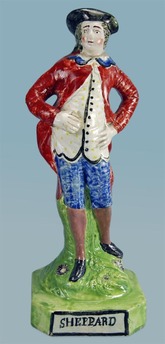 Last year, I blogged about this figure, titled SHEPPARD. He is from the same molds as Aurea's shepherd, but he isn't a bucolic gentleman. Instead, he is the notorious gangster, Jack Sheppard. You can read the story here. In catagorizing figures for the chapters in my book, I never cease to be amazed at the array of shepherds. Dividing figures by subject matter is not easy. As you know, very many figures include a small sheep or dog or a musical instrument. So when is a figure a shepherd, when is it a musician, and when is it a person with a dog? In many cases, there is no right answer....but I have battled on and done my best. Among the many shepherds, I think this pair are really rather spectacular. This is the only pair of shepherds in classical attire that I have been able to record. Yes, each holds a sheep, and they reside in the Potteries Museum. A similar single candlestick (creamware, unpainted, the male figure) impressed "Neale & Co" is documented, so perhaps James Neale made these too. The enamels are certainly typical of the Neale period of the 1780s. 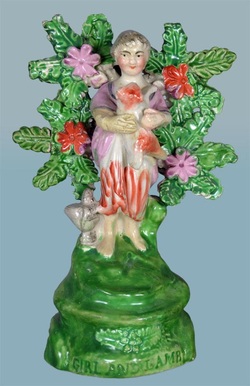 A much, much humbler figure in my Shepherds folder is this little girl with a lamb. Appropriately titled GIRL AND LAMB, it was probably made in the 1820s. The model is like that produced by Ralph Salt and other potters of the period. What makes this little figure unusual are the loopy, daisy-like flowers on the bocage. All the other figures with these daisies on their bocages are of this scale, and I have documented pairs for all of them....all of them barring one, that is. This strange little lion, formerly in Andrew Dando's stock, has yet to find his mate. This lion (titled LION on the front of the base) has the sweetest, most animated face, but something went wrong in the firing. I think there were two issues. Firstly, the temperature was probably too high, causing the glazes to lose their glossiness--I think they evaporated in the excess heat. Secondly, dirt, perhaps from the saggar containing the lion, stuck to the glaze. You can see this mainly beneath the base. Remember that in those days, there was not even a way to measure kiln temperatures, so mishaps of this sort might be expected. Despite this, I find the lion strangely beautiful, and he lives with me as a reminder that even a bad day can be salvaged!
I went to our farmer's market yesterday and stopped to talk to the local potter. She had promised to make me some additional mugs to add to some I bought last year. I listened as she complained about the impossible task of replicating the glaze color. Added to this, she is having trouble with her glaze bubbling. Today, glazes and clays are standardized, and kilns fire to a digitally pre-set temperature. Also, my mugs required just one firing--not the three that my little lion needed. How far we have come....or have we?? If you have a figure with loopy daisies on the bocage, please let me hear from you. "Sherratt" figures are perenially popular with collectors, so the "Sherratt" label gets applied too quickly--or too wishfully. Currently, there are two particularly nice "Sherratt" offerings in the stock of dealers. This set of figures of Faith, Hope, and Charity is in the stock of Andrew Dando. I think that they are particularly pretty. I love their dresses and bases, and the faces are charming. How do I know these are "Sherratt"??? Two clues:
The other newsworthy "Sherratt" offering floating in cyberspace is this pair of figures of the Welch Tailor and his wife, from the stock of John Howard. "Sherratt' figures on this subject are rare. They occur on two base forms, this being the rarer. I have seen this pair of figures, as well as only one other pair on the same unusual bases. On that other pair, the perky baby goat standing beneath its mother was not present. You really need to see these figures close up to appreciate the quirky expressions, and Sherratt enamels and glazes are particularly pleasing. The reason for the attribution is a bit more complex here, but I am certain these were made by "Sherratt." As for why I am spelling Welch with a "c" rather than an "s"....well, you need to know the figures' story. You can read it here in an old blog posting. By coincidence, it was written right after I first saw these very figures. I find absolutely no basis for attributing a weirdly wondrous watch stand in John Howard's stock to "Sherratt" or to anyone else. Amazingly, it still has the original watch in place! I have a very similar watch stand in my collection. You see it below....with a watch off eBay in place. Notice that there are holes in the top of my watch stand to anchor the T-bar at the end of the watch chain. Nice touch! Why do I mention these watch stands in the same breath as "Sherratt"? Well, the two men flanking the watch stands also occur on large "Sherratt" PREPARE TO MEET THY GOD groups (see my book). They are tyler masons, charged with ensuring that only permitted attendees enter masonic mettings. "Sherratt" also made the two tyler masons as separate figures, as you see below. Although the watch stands seem to link to "Sherratt" because of the presence of the tyler masons, I don't believe "Sherratt" made them. Instead, this is just one of those instances of plagiarism or shared molds. That happened often in the Potteries. The links between figures are endlessly fascinating. Figures are more than mere pretty objects, and delving into them reveals many mysteries and, with luck, a few answers!
For too long, I have been fine-tuning my work on Ralph Wood enamel-painted figures for a paper I am reading this fall. It's sort of like untangling a ball of wool. One thing leads to another, and it is never simple. Ralph Wood has been dead for 217 years, so we should have figured this out by now! As you know, Ralph Wood figures often have impressed mold numbers, and you can encounter identical figures with or without a number. In my mind, I am certain that Ralph Wood figures happened in this sequence.
It makes sense that a manufactory that operated for almost 30 years tweaked its production in this way. Changes were evolutionary rather than revolutionary, and essentially, the figure molds tended to be the same. There was no need to modify the figure molds, just the painted details--and perhaps add a bocage. But there is an exception to every rule, and Ralph Wood's larger figures of gardeners underwent some modifications along the way. Let's look at it step-by-step: 1. The first figures look like the pair below. These are impressed "8" and "9". They are from John Howard's archive. I think these were made very early in the Ralph Wood era because of their low numbers in the 170-number range that Ralph used. 2. I might have expected that, as time went on, Ralph Wood would have made the same figures but without those numbers. After all, that is what happened in every other case. But clearly something about those heads worried Ralph. Perhaps the hats weren't stylish enough, so he remade the hats/heads. The spiffy pair below is in the stock of Barbara Gair/Castle Antiques. 3. Stage three has Ralph Wood adding bocage. Here are two lady gardeners, one titled and the other not, with typical Ralph Wood bocages. They are in the stock of Elinor Penna and Martyn Edgell. 4. Stage four sees the same figures painted in muddier tones and titled in large black script. This is typical of figures we associate with the tail-end of the Ralph Wood era. We tend to think figures like these are a little later because enamels underwent changes as the decades marched on. Nonetheless, these are still very early figures. The lady is in the Potteries Museum. The gentleman belongs to a very nice collector. I am as certain as I can be from pictures that the lady's hat has not undergone any change in these final figures, but I will be able to verify that at the museum later this year. Meanwhile, if you have a Ralph Wood Mate of this form, please shout. Last but not least, I pose a question. Have you any idea why there is often a little face on the water source on gardening figures and groups? You can see a face quite clearly on one of my favorite ruins: a partial figure excavated from the Old Town Hall site in Burslem associated with Enoch Wood. This figure is now in the Potteries Museum. If you have any guesses as to the reason for a face, please share your thoughts.
Born and raised in Africa, I love the feeling of warm earth beneath my bare feet, so even as the mercury rises to all-time highs in North Carolina, I don't long for winter. But Staffordshire figures of Winter are another story. Yes, we are all familiar with a portly man wearing skates, surely the most common portrayal of the Winter season. But far, far nicer is this lady wearing a coat with a huge fur collar, currently on Aurea Carter's site. The figure is after an early nineteenth century print, which you see here applied to glass. The lady in the print wears skates, but the earthenware lady never has skates. This figure is 9", so it has Presence. Of course, it is part of a set of figures emblematic of the four seasons. I know of only one complete set, and you can see it in all its glory in my book. Here is Winter from that set. This figure of Winter, like the others in the set, is marked WALTON. I know of two other Walton seasons. These are odd figures. I don't know of another set. The first time I saw this set, it resided in the home of a charming older gentleman, who lived alone. I went into the bathroom to see the figures. One sat on each corner of the bathtub. It was time to pray to the Pottery God for their survival! Clearly, that has worked for the figures are still with us. Figures of the Seasons on this scale occur on sundry other bases. I am not at all certain that John Walton made any of the unmarked examples. In fact, I bet they were made by other potters. The figures occur in underglaze colors and enamels, just to deepen the attribution mystery--in fact, I think Aurea's figure is underglaze. I thought you might like to see these two examples in my archive, courtesy of Elinor Penna. My archive is large, and it has taken a long time to build....so please don't think figures like this grow on trees. They are rather uncommon. Sometimes you will find a pair, which probably results from a collector having made the happy match. Notice that the two figures above and Aurea's figure all have a low scroll-type structure behind them. Its not quite a bocage, but I am not sure what to call it. I have only ever seen this on figures of Seasons. It occurs on one example of the gentleman-on-skates, the common figure of Winter that we all know best. In all other instances, it is on the lovely large ladies that accompany our lady with the large fur collar. In one instance, it is on a figure of Spring marked Walton. If all this is too much information, hang in there just a moment longer. To bring us full circle, I want to show you another figure of Spring. This example, from the stock of Elinor Penna, is on the same lovely base as Aurea's figure of Winter. Enjoy the heat, while it lasts. And if you like winter, grab Aurea's figure, while it lasts!
|
Archives
September 2023
All material on this website is protected by copyright law. You may link to this site from your site, but please contact Myrna if you wish to reproduce any of this material elsewhere. |
